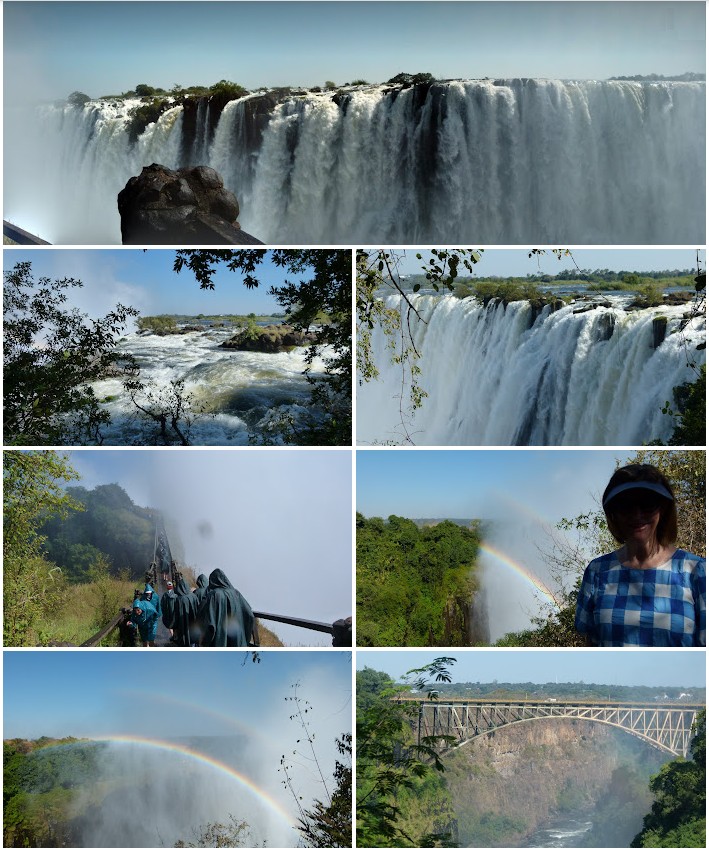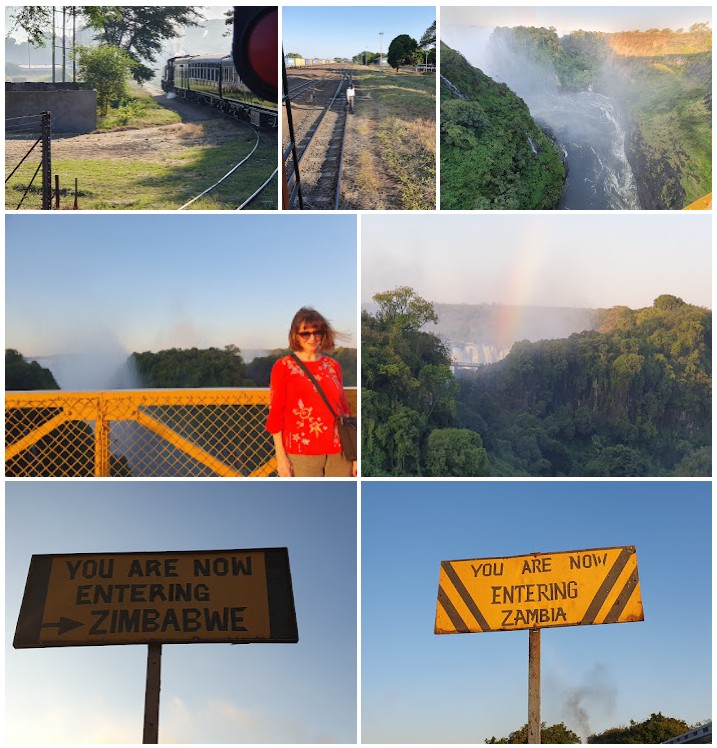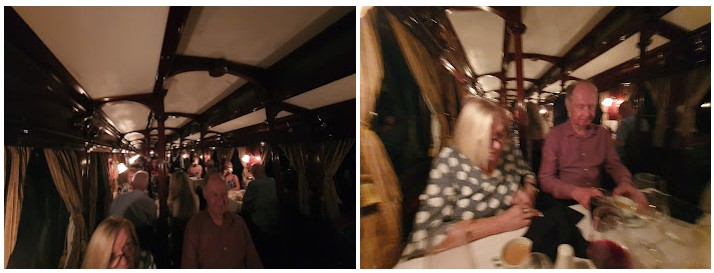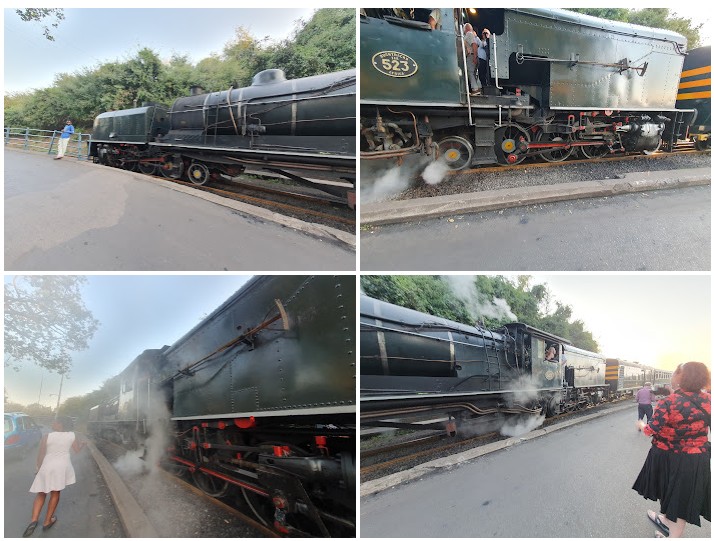
Apparently Victoria Falls have moved. When I was at school they were in Rhodesia, our Imperial cousin, marked in pink on the big world map and remembered, jingoistically, each Empire Day. Since then they've been peripatetic or at the very least, vacillating, between: Zambia and/or Zimbabwe.
Livingstone, in Zambia, is noticeably different to towns in South Africa. It hasn't grown much since 1979.
Much of the infrastructure - including the ever-present electric fences - is in ruin. The town itself is fine but one-time orchards now seem to feed the elephants and we were told that the fences don't stop them. The elephants have learnt to throw a tree branch over the fences to short them out and even brick walls don't stop them.
There's no need to go on safari to see zebra, giraffe, or elephants, not to mention monkeys and baboons, they're wandering along the roadside.

Centre-right (above) is our local zebra that, in the resort minibus, we passed several times.
My joke of the day: "Sometimes he's on one side, sometimes on the other. On the road he's a zebra crossing".
'David Livingston Safari Lodge and Spa' in Zambia, is one of several on the Zambezi River, above Victoria Falls. Our first night we were taken on a river cruise to see some of the wildlife, while enjoying drinks and a light meal.

Out on a river cruise we saw, at last, quite a few hippopotamus (Oh My?), a herd of buffalo, and another crocodile (a small one that had invaded the hotel pond). Walking between resorts signs warn of crocodiles, that might leap out and eat you; and Hippos, that like to kill people for no good reason, as they are vegetarian.
Victoria Falls result when the river plummets into a transverse chasm: Batoka Gorge (1,708 metres wide and 108 metres deep). Due to the unusual geology, the river has eroded, over time, zig-zag fashion, a succession of, almost parallel, trench-like gorges, at the edge of the escarpment.
So, on land, it's not possible to stand sufficiently back to get a panoramic view, as at Iguazu or Niagara. Nor can one approach them from below by boat.
 Source Wikipedia: "Diego Delso, delso.photo, License CC-BY-SA"
Source Wikipedia: "Diego Delso, delso.photo, License CC-BY-SA"
Instead, just over 100 metres in front of the cataract there is a long stretch of land that allows one to see them up-close, from various vantage points, and to get wet from the spray. At one point, a gap is crossed, by a narrow pedestrian bridge, over the 108 metre drop, where one gets very wet indeed. Needless to say, it's not a place for those scared of heights or those worried about aging bridges, in a country not renowned for its ongoing maintenance of Imperial hangovers.
Victoria Falls claim to be the largest in the world. They are roughly twice the height of Niagara Falls and well over twice its width. Yet they are not as impressive as Iguazu Falls, composed of several hundred separate cascades - that's much more spectacular.
Nevertheless, like all great waterfalls, Victoria Falls are awe inspiring. At one point, just above the falls, and meters from the edge, the bank is close to the path and river rushes past close your feet. There's no fence. If there ever was, its probably been swept away.
One false step and: "see you in bits at the bottom".

Victoria Bridge (above), another Imperial hangover, is the only crossing, of the 'mighty Zambezi', into Zimbabwe. The little white box in the middle houses the bungee-jumping platform.
Zambia's principal export is copper (metallic copper and copper ore). All these trucks, carrying copper metal, are lined up to cross the Victoria Bridge into Zimbabwe.

Our tour package included a five course gourmet dinner on a luxury train, that would stop on the Victoria Bridge for a unique view of the falls.

Over Wendy's shoulder you can see the very wet foot bridge that we traversed earlier in the trip and from which I photographed this bridge.
The train turned out to be pulled - or rather pushed by an historic Garratt steam locomotive, once run by Rhodesian Railways. It was beautifully maintained and the meal was excellent, with a bottomless supply of wine and soft dinks.
 Was it the alcohol or the train shaking when I snapped these photos?
Was it the alcohol or the train shaking when I snapped these photos?
While the train itself was immaculate, the same could not be said for the track and trackside infrastructure, much of which lay in ruins. A small bridge, over a culvert, looked decidedly unsafe and our trainman, who leapt out to change the points, seemed relieved when we got over it.
At one point even the trackside brick walls had collapsed sections and we were told that it was the work of the elephants that wander about.
It was also interesting that the heavy Garratt engine and its accoutrement (tender, etc) stayed firmly on the land, having reversed the lighter carriages onto the bridge.
When I was a boy the NSW Government Railways had a brief romance with Garratts for hauling freight trains and when one passed our Primary School some one would shout 'Garratt' and we would all watch it pass by. So it brought back some fond memories. The line was electrified for suburban trains but the electrification did not extend all the way to Newcastle and, in any case, freight trains were too heavy for electric locos that would draw too much current, they were the days of mercury-arc rectification (before high power silicon semi-conductors).
But coal was soon to be replaced by diesel-electric locomotives.

Wikipedia tells me:
Rhodesia imported 246 Garratts of four different wheel arrangements. Many went to Zambia Railways in 1967 when Rhodesia Railways surrendered the lines in Zambia to its government. Zimbabwe's economic and political situation has extended the life of its Garratts.
Later, we crossed into Zimbabwe by bus to the airport, a somewhat fraught experience, on the start of our long journey home.
If you are interested in more photographs or just want to see one in more detail - click on the image below
